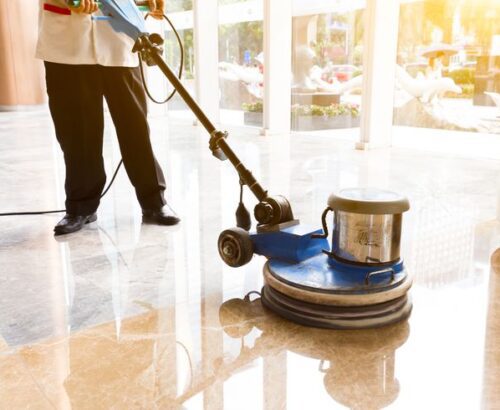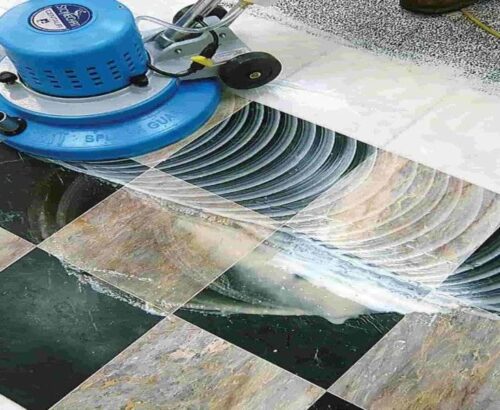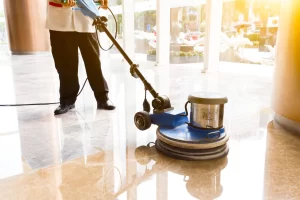Marble surfaces exude timeless beauty and elegance, making them a sought-after choice for various architectural and design projects. However, the natural wear and tear, foot traffic, and environmental factors can gradually diminish the luster and appeal of marble surfaces over time. That’s where marble polishing and marble restoration services come into play. These professional services aim to revive and rejuvenate marble installations, whether it’s a grand flooring, a stunning countertop, or intricate sculptures. In this blog post, we will delve into the world of marble polishing services in Faridabad and restoration, exploring their significance, processes, and benefits. By understanding the key differences between these two services, you’ll be equipped with the knowledge to make informed decisions and restore the splendor of your marble surfaces.
Importance of Marble Polishing and Restoration:
Marble Polishing:
marble floor cleaning is a meticulous process designed to restore the shine, brilliance, and smoothness of marble surfaces. Over time, foot traffic and everyday use can result in scratches, scuffs, and a dull appearance. By engaging professional marble polishing services, you can regain the mirror-like finish that initially drew you to marble. This not only enhances the aesthetics but also protects the surface from further damage. A Marble polishing not only brings back the natural beauty of the stone but also contributes to a healthier and cleaner environment by eliminating stains and contaminants.
Marble Restoration:
It restoration services go beyond the surface-level treatment provided by polishing. Restoration involves comprehensive repairs and refurbishment of marble surfaces, addressing more severe issues such as cracks, chips, deep stains, and structural damage. The goal of restoration is to revitalize and rejuvenate the marble, bringing it back to its former glory. Whether it’s an antique marble sculpture or a historical architectural feature, restoration ensures the preservation of artistic, cultural, and historical value. It involves specialized techniques, including cleaning, repairs, and color matching, to seamlessly blend the restored areas with the original surface.
Understanding the Difference:
While both marble polishing and restoration aim to enhance the appearance of marble surfaces, they differ in their scope and purpose. Polishing primarily focuses on surface-level imperfections, such as minor scratches and dullness, to restore the shine and luster. On the other hand, restoration addresses more extensive damage, including structural issues, deep stains, and noticeable chips or cracks. Restoration involves a combination of cleaning, repairs, and refinishing to bring back the marble’s original splendor.
Benefits of Marble Polishing and Restoration Services:
Engaging professional marble polishing and restoration services offers numerous benefits, including:
1. Restored Beauty: Revive the natural beauty and elegance of marble surfaces, enhancing the overall aesthetics of your space.
2. Increased Lifespan: By addressing damage and preventing further deterioration, polishing and restoration help extend the lifespan of marble installations.
3. Preservation of Value: Restoration preserves the historical, artistic, and monetary value of antique or culturally significant marble pieces.
4. Improved Hygiene: Proper cleaning and polishing remove stains, dirt, and bacteria, contributing to a healthier living or working environment.
5. Cost-effectiveness: Timely maintenance and restoration can prevent the need for costly replacements, making it a cost-effective investment in the long run.

Marble Restoration: Repairing and Revitalizing
marble cleaning and restoration refers to the process of repairing and revitalizing damaged or deteriorated marble surfaces to bring them back to their original condition. The purpose of restoration is to address various issues such as stains, chips, cracks, and wear and tear, ensuring that the marble regains its functionality, beauty, and structural integrity.
Identification of various issues that require restoration:
Marble restoration becomes necessary when marble surfaces encounter significant problems, including:
1. Deep stains and discoloration: Over time, marble can develop stubborn stains or discoloration due to exposure to acidic substances, improper cleaning methods, or environmental factors. These stains penetrate the surface, making regular cleaning ineffective in removing them.
2. Chips, cracks, and structural damage: Marble surfaces are susceptible to chips, cracks, and other forms of structural damage. These issues can occur due to impact, heavy objects being dropped, or natural wear and tear. They not only compromise the appearance of the marble but also weaken its structure.
3. Loss of marble surface due to wear and tear: With regular use and foot traffic, marble surfaces can gradually wear down, resulting in a loss of the top layer. This leads to a dull and uneven appearance, making restoration necessary to revive the surface.
Overview of the restoration process and techniques used:
marble and stone restoration involves a series of steps to address the identified issues and restore the marble surface. The restoration process may include:
1. Thorough cleaning: The marble surface is carefully cleaned using appropriate products and techniques to remove dirt, grime, and any residual coatings.
2. Repairing chips and cracks: Chips and cracks are meticulously repaired using suitable filling materials, such as epoxy or resin, to restore the integrity and smoothness of the surface.
3. Grinding and honing: If the surface has unevenness, deep stains, or minor scratches, grinding and honing techniques are employed. This process involves using abrasive pads and gradually smoothing the surface to eliminate imperfections.
4. Polishing and refinishing: The marble is polished using specialized compounds, powders, and polishing machines to achieve a smooth, glossy finish. This step restores the natural shine and luster of the marble, enhancing its aesthetic appeal.
5. Sealing and protecting: To protect the restored marble surface from future damage, a suitable sealer is applied. This helps prevent stains, moisture penetration, and wear, extending the longevity of the restoration work.
Benefits of marble restoration:
1. Repairing and revitalizing damaged marble surfaces: Marble restoration effectively addresses issues such as stains, chips, cracks, and surface deterioration, bringing the marble back to its original condition. This process rejuvenates the marble’s appearance and functionality, making it look fresh and appealing once again.
2. Extending the lifespan of marble installations: By restoring the structural integrity of the marble, restoration helps extend its lifespan. It prevents further damage and deterioration, ensuring that the marble can withstand future use and environmental factors.
3. Preserving the historical and aesthetic value of marble: Marble surfaces often hold historical, cultural, or artistic significance.

Different objectives of marble polishing and restoration
Marble polishing and restoration serve different objectives based on the specific needs and conditions of marble surfaces. Here are the distinct objectives of marble polishing and restoration:
Marble Polishing:
The primary objective of marble polishing is to restore the shine, luster, and smoothness of the marble surface. It focuses on enhancing the aesthetic appeal of the marble by eliminating surface imperfections and bringing out its natural beauty. The key objectives of marble polishing include:
1. Restoring the natural shine and luster: Polishing removes dullness and restores the glossy finish of the marble, making it visually appealing and vibrant.
2. Eliminating surface imperfections: The polishing process effectively reduces or eliminates minor scratches, scuffs, and marks on the marble surface, creating a more uniform appearance.
3. Enhancing the overall aesthetics: marble floor polishing company enhances the beauty and elegance of the surface, showcasing the unique veining, color variations, and patterns inherent in the marble.
Marble Restoration:
marble floor polishing company goes beyond surface-level treatment and aims to address more significant issues and damage to the marble surface. The objective of restoration is to repair, revitalize, and bring the marble back to its original condition. The key objectives of marble restoration include:
1. Repairing damaged areas: Restoration focuses on repairing chips, cracks, and structural damage to restore the integrity and functionality of the marble surface.
2. Revitalizing the appearance: Restoration aims to rejuvenate the marble’s appearance by removing deep stains, discoloration, or wear and tear that cannot be resolved through polishing alone.
3. Preserving historical and aesthetic value: Restoration is often crucial for preserving the historical or cultural value of marble surfaces, such as antique sculptures or architectural landmarks. It ensures that the marble retains its authenticity and original beauty.

Tools, Equipment, and Techniques Used in Each Process:
Marble Polishing:
1. Polishing Machines: Specialized rotary machines equipped with diamond-impregnated pads or discs are commonly used for marble polishing. These machines provide the necessary friction and pressure to achieve a smooth, glossy finish.
2. Polishing Compounds or Powders: Various polishing compounds or powders are applied to the marble surface during the polishing process. These products help in removing scratches, smoothing the surface, and bringing out the shine.
3. Diamond Abrasive Pads: Diamond-impregnated pads of varying grit levels are utilized for grinding, honing, and polishing marble surfaces. These pads efficiently remove imperfections and refine the surface texture.
Marble Restoration:
1. Repair Materials: For restoring damaged marble, epoxy or resin-based fillers are commonly used to repair chips, cracks, and structural issues. These materials ensure a durable and seamless repair.
2. Grinding and Polishing Tools: Similar to marble polishing and restoration may involve the use of rotary machines with diamond-impregnated pads or discs. These tools are utilized for grinding, honing, and polishing to repair and rejuvenate the marble surface.
3. Cleaning Agents: Specific cleaning agents and solutions are employed to remove deep stains, discoloration, and ingrained dirt during the restoration process. These agents are formulated to be safe for marble while effectively removing tough stains.
Factors Influencing the Choice Between Polishing and Restoration:
1. Severity of Damage: The extent of damage on the marble surface is a significant factor in determining whether polishing or restoration is required. Minor scratches and dullness can often be addressed through polishing, while significant damage such as deep stains, chips, or cracks may necessitate restoration.
2. Desired Outcome: Consider the desired result for the marble surface. If the goal is to simply enhance the shine and remove minor imperfections, polishing may suffice. On the other hand, if the aim is to repair and revitalize a heavily damaged surface, restoration is the appropriate choice.
3. Historical or Cultural Significance: Marble surfaces with historical or cultural significance may require restoration to preserve their authenticity and value. Restoration ensures that the original beauty and integrity of these marbles are maintained.
4. Time Constraints: Polishing typically requires less time compared to restoration, as restoration involves more comprehensive repairs and refurbishment. Consider the time available for the project when deciding between the two options.
5. Budget Considerations: The cost of marble polishing and restoration can vary depending on the extent of the work required. Generally, restoration tends to be more expensive due to the additional repairs and materials involved.

Time and Cost Considerations for Marble Polishing and Restoration:
Time Considerations:
1. Marble Polishing: The time required for marble polishing depends on the size of the area and the condition of the marble surface. For small residential projects, polishing can typically be completed within a day or two. Larger commercial projects may take longer, depending on the scope of work and the number of surfaces to be polished.
2. Marble Restoration: The time needed for marble restoration varies significantly based on the extent of damage and the size of the project. Restoring heavily damaged or large areas may take several days or even weeks. The restoration process involves additional steps such as repairing chips, cracks, and structural issues, which require more time and expertise.
Cost Considerations:
1. Marble Polishing: The cost of marble polishing services is influenced by factors such as the size of the area, the level of polishing required, and the location of the project. Generally, polishing is more affordable compared to restoration, as it primarily focuses on surface-level treatments. The cost is typically calculated based on square footage or hourly rates of the polishing service provider.
2. Marble Restoration: Marble restoration tends to be more expensive than polishing due to the additional repairs, materials, and labor involved. The cost of restoration depends on the extent of damage, the complexity of repairs needed, and the size of the project. Factors such as the type of repairs, specialized tools or equipment required, and the expertise of the restoration professionals can contribute to higher costs.
Conclusion:
Marble restoration is a comprehensive process that involves repairing and revitalizing damaged marble surfaces. It addresses issues such as stains, chips, cracks, and wear and tear, utilizing techniques like cleaning, repairing, grinding, honing, polishing, and sealing. The benefits of marble restoration include repairing and revitalizing damaged surfaces, extending the lifespan of marble installations, and preserving the historical and aesthetic value of marble.




